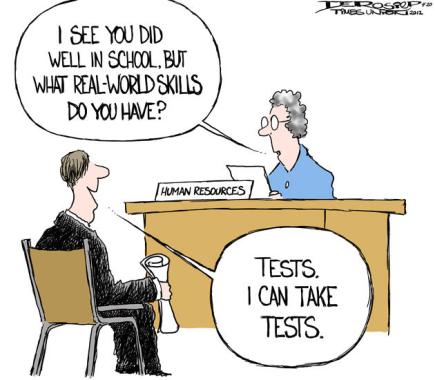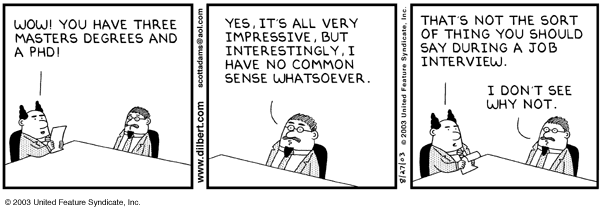Media reports have focused on a recent survey indicating a sharp decline in support for the Common Core among teachers. These reports have also included a variety of explanations and theories as to why this decline has occurred.
Unfortunately much of the speculation comes from Common Core cheer leaders who have limited teaching experience and do not have regular contact with students or teachers so they lack the wisdom derived from classroom experience along with any evidence to support their claims.
From my perspective, teachers no longer have confidence in the ability, or trust the motives, of the cognitively privileged but unqualified Common Core A-Team that was tasked with constructing National Learning Standards that should be RESPONSIVE, to the academic, social, vocational, and emotional needs of diverse learners.
Simply put, teachers have lost their patience and grown tired of the litany of disingenuous, contradictory, self-serving, and evidence-less claims.
Here is a partial list of problems and concerns regarding the efficacy of the Common Core State Standards…
#1 Teaching To The Test
There is no better example of conflicting and contradictory statements than the issue of teaching to the test. Back in 2012, President Obama said…
And one of the reasons that we have sought reforms to No Child Left Behind. I think it had great intentions. I give President Bush credit for saying, “Let’s raise standards and make sure that everybody’s trying to meet them.” But because so much of it was tied just to standardized testing, what you saw across the country was teaching to the test.
And I– I can’t tell you how many teachers I meet who say, “You know what? This makes school less interesting for kids. And as a consequence, I’m ending up really shrinking my curriculum, what I can do in– in terms of creativity inside of the classroom.” And that’s not how you or I, for example, when we think about our best teachers, we don’t think about studying a bunch of tests to see how we’re going to score on a standardized test
Recently U.S. Secretary of Education Arne Duncan commented on the U.S. Department of Education Blog…
But the larger issue is, testing should never be the main focus of our schools. Educators work all day to inspire, to intrigue, to know their students – not just in a few subjects, and not just in “academic” areas. There’s a whole world of skills that tests can never touch that are vital to students’ success. No test will ever measure what a student is, or can be. It’s simply one measure of one kind of progress. Yet in too many places, testing itself has become a distraction from the work it is meant to support.
I believe testing issues today are sucking the oxygen out of the room in a lot of schools – oxygen that is needed for a healthy transition to higher standards…
Contrast the comments above with this excerpt from a 2011 Keynote Speech given by David Coleman, the chief author and architect of the Common Core State Standards…
… these standards are worthy of nothing if the assessments built on them are not worthy of teaching to, period…our top priorities in our organization, and I’ll tell you a little bit more about our organization, is to do our darnedest to ensure that the assessment is worthy of your time, is worthy of imitation.
It was Lauren who propounded the great rule that I think is a statement of reality, though not a pretty one, which is teachers will teach towards the test. There is no force strong enough on this earth to prevent that. There is no amount of hand-waving, there‟s no amount of saying, “They teach to the standards, not the test; we don‟t do that here.” Whatever. The truth is – and if I misrepresent you, you are welcome to take the mic back. But the truth is teachers do.
Tests exert an enormous effect on instructional practice, direct and indirect, and its hence our obligation to make tests that are worthy of that kind of attention. It is in my judgment the single most important work we have to do over the next two years to ensure that that is so, period.
So who are we to believe regarding teaching to the test?
No better way to learn if teachers will need to devote extra class time to training and test prep for the Common Core assessments than to look at a sample question like the one published in Valerie Strauss’s “Answer Sheet” Blog,
Consider this fourth-grade question on the test based on a passage from Pecos Bill Captures the Pacing White Mustang by Leigh Peck.
Why is Pecos Bill’s conversation with the cowboys important to the story?
A) It predicts the action in paragraph 4
B) It predicts the action in paragraph 5
C) It predicts the choice in paragraph 10
D) It predicts the choice in paragraph 11
Claims that the Common Core ELA literacy standards will prepare our children for college and careers are patently false and misleading.
The contrived and artificial Close Reading skills (see #2) required to answer the above test question are not realistic or properly aligned with the real life literacy demands of post-secondary learning and employment.
The convoluted format and design of Common Core test questions clearly call for test prep, as students will need time to practice and prepare for questions like this.
David Coleman’s comment and the sample test question above are evidence of the Data-driven philosophy and mindset of many Common Core enthusiasts who believe the “needs” of the test should drive instruction, rather than the literacy needs of the student.
Experienced educators appreciate and understand that the diverse needs of students must be the number one priority of any education program that claims to prepare students for adulthood and employment.
The misguided data-driven and test-centered approach means teachers are spending more and more class time training and preparing students for Common Core tests, rather than preparing them for life.
A 2012 Report: “Learning Lesson” details the results of a national teacher survey regarding Common Core implementation…
- About half (51%) of elementary school teachers say that struggling students get extra help in math or language arts by getting pulled out of other classes; the most likely subjects are social studies (48%) and science (40%)
- 59% of elementary school teachers report that social studies has been getting less instructional time and resources (28% middle school; 20% high school); 46% say the same about science (20% middle school; 14% high school)
Close reading is a central focus of the the Common Core ELA Standards.
Timothy Shanahan explains…
…A first reading is about figuring out what a text says. It is purely an issue of reading comprehension. Thus, if someone is reading a story, he/should be able to retell the plot; if someone is reading a science chapter, he/she should be able to answer questions about the key ideas and details of the text…
However, close reading requires that one go further than this. A second reading would, thus, focus on figuring out how this text worked. How did the author organize it? What literary devices were used and how effective were they?…
This process is very challenging and time consuming for advanced and grade level readers and is confusing, dispiriting, and not even independently obtainable for many weaker and learning disabled students.
More troubling is the fact that so many elementary students are losing time in other subject areas to spend extra class time on Close Reading activities when it is not an essential literacy skill for learning or work. Reducing time in other subject areas to focus on close reading is clearly about preparing students for close reading Common Core tests and not about preparing them for college and careers. The day-to-day reading demands of most jobs are NOT “rich and worthy” of close reading.
The National Institute for Literacy has identified and defined 16 content and national learning standards that will help students be “Equipped for The Future”. These standards do not require close reading skills. Instead they require literacy skills that are broad-based and transferable to real life learning situations where students and employees must “Read With Understanding”…
”define the knowledge and skills adults need in order to successfully carry out their roles as parents and family members, citizens and community members, and workers. Keeping a focus clearly on what adults need literacy for, EFF identified 16 core skills that supported effective performance in the home, community, and workplace.”
Teachers take their job very seriously and they have great admiration, respect, and high expectations for their students. More and more teachers do not support the Common Core Standards because they do not prepare students for the real life literacy demands of college and careers.
“Math used to be a struggle for 14-year-old Kathryn, until she fell in love with cars and started a hands-on project to build her own. Now the math matters and makes sense, and a whole new world of learning has opened up for her.”
Rather than just preparing students for college and careers, every student should have the opportunity to actually practice career skills by participating in internships and work-based learning experiences.
It is difficult for teachers to support the Common Core and take the college and career readiness claims seriously when there are no trade, vocational, or work experience standards, especially at a time when there is a growing demand for such workers…
“The heavy proportion of older skilled-trade workers puts into focus more than just the pending retirement for baby boomers and oft-cited but rarely quantified gap between the skills that employers need and available workers possess. It also touches on the fact that American high schools have largely shifted their focus to preparing students for four-year colleges rather than vocational school.But just as training to become a welder or computer controlled machine operator isn’t for everyone, pursuing a college degree doesn’t fit every student’s skill set…”
#4 Teachers and employers do care about thoughts and feelings.
“A comprehensive determination of college and career readiness that would include additional factors (such as persistence, motivation, and time management…) is beyond the scope of the PARCC assessments in ELA/literacy and mathematics…Since these non-academic factors are so important, PARCC College- and Career-Ready Determinations can only provide an estimate of the likelihood that students who earn them have the academic preparation necessary to succeed in entry-level, credit-bearing courses.”
It is a thousand times better to have common sense without education than to have education without common sense.



Pingback: Common Core: Growing Pains or Growing Awareness? | WagTheDog | MI ED News Clips
Pingback: Literacy and the Common Core | MI ED News Clips
Pingback: David Coleman | MI ED News Clips
Pingback: Critical Thinking vs. Creative Thinking | WagTheDog
Pingback: Learning Standards | WagTheDog
Pingback: Weekly Roundup 8/29/14 | Truth in Teaching
Pingback: Common Core Bait and Switch | WagTheDog
Pingback: A Clever Way To Share Student Data | WagTheDog
Pingback: Is Your School Directly Sharing Student Data with Third Parties? That’s Clever. | Missouri Education Watchdog
Pingback: #whatif… | WagTheDog
Pingback: Comfort in Disruption | Seminar in Digital Authorship